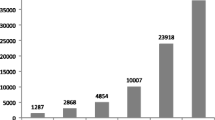Summary
Close structural resemblances between several mammalian highly or moderately repetitive families and some specific tRNAs were detected. The rodent type 2 Alu family, rat identifier (ID) sequences, rabbit C family, and bovine or goat 73-bp repeat are most homologous with lysine tRNA5, phenylalanine tRNA, glycine tRNA, and glycine tRNA, respectively. The homologies extend to secondary structures, and the homologous nucleotides are located on nearly the same secondary structures. The repetitive families mentioned have a common structural organization, with a tRNA-like sequence devoid of an aminoacyl stem region. These features suggest that these repetitive families may be generated by nonhomologous recombination between a tRNA gene and a tRNA-unrelated block.
Similar content being viewed by others
References
Allan M, Paul J (1984) Transcriptionin vivo of an Alu family member upstream from the human ε-globin gene. Nucleic Acids Res 12:1193–1200
Ames BN, Tsang TH, Buck M, Christman MF (1983) The leader mRNA of the histidine attenuator region resembles tRNAHis: possible general regulatory implications. Proc Natl Acad Sci USA 80:5240–5242
Buck M, Ames BN (1984) A modified nucleotide in tRNA as a possible regulator of aerobiosis: synthesis of cis-2-methylthioribosylzeatin in the tRNA ofSalmonella. Cell 36:523–531
Cheng J-F, Printz R, Callaghan T, Shuey D, Hardison RC (1984) The rabbit C family of short, interspersed repeats. J Mol Biol 176:1–20
Duncan C, Biro PA, Choudary PV, Elder JT, Wang RRC, Forget BG, De Riel JK, Weissman SM (1979) RNA polymerase III transcriptional units are interspersed among human non-α-globin genes. Proc Natl Acad Sci USA 76:5095–5099
Galli G, Hofstetter H, Birnstiel ML (1981) Two conserved sequence blocks within eukaryotic tRNA genes are major promoter elements. Nature 294:626–631
Haynes SR, Jelinek WR (1981) Low molecular weight RNAs transcribedin vitro by RNA polymerase III from Alu-type dispersed repeats in Chinese hamster DNA are also foundin vivo. Proc Natl Acad Sci USA 78:6130–6134
Jagadeeswaran P, Forget BG, Weissman SM (1981) Short interspersed repetitive DNA elements in eukaryotes: transposable DNA elements generated by reverse transcription of RNA pol III transcripts. Cell 26:141–142
Krayev AS, Markusheva TV, Kramerov DA, Ryskov AP, Skryabin KG, Bayev AA, Georgiev GP (1982) Ubiquitous transposon-like repeats B1 and B2 of the mouse genome: B2 sequencing. Nucleic Acids Res 10:7461–7475
Matsumoto K, Murakami K, Okada N (1984) Pseudouridylic modification of a 6S RNA transcribedin vitro from highly repetitive and transcribable (Hirt) sequences of salmon total DNA. Biochem Biophys Res Commun 124:514–522
Milner RJ, Bloom FE, Lai C, Lerner RA, Sutcliffe JG (1984) Brain-specific genes have identifier sequences in their introns. Proc Natl Acad Sci USA 81:713–717
Mueller F, Clarkson SG (1980) Nucleotide sequence of genes coding for tRNAPhe and tRNATyr from a repeating unit ofX. laevis DNA. Cell 19:345–353
Nishimura S (1979) Modified nucleotides in tRNA. In: Shimmel PR, Söll D, Abelson JN (eds) Transfer RNA: structure, properties and recognition. Cold Spring Harbor Laboratory, Cold Spring Harbor, New York, pp 59–79
Okada N, Nishimura S (1979) Isolation and characterization of a guanine insertion enzyme, a specific tRNA transglycosylase, fromEscherichia coli. J Biol Chem 254:3061–3066
Okada N, Sakamoto K, Kondo A (1983) Total DNA transcription reveals the existence of highly repetitive transcribable sequences in higher animals. J Biochem (Tokyo) 93:723–731
Page GS, Smith S, Goodman H (1981) DNA sequence of the rat growth hormone gene: location of the 5′ terminus of the growth hormone mRNA and identification of an internal transposon-like element. Nucleic Acids Res 9:2087–2104
Rubin CM, Houck CM, Deininger PL, Freidmann T,Schmid CW (1980) Partial nucleotide sequence of the 300-nucleotide interspersed repeated human DNA sequences. Nature 284:372–374
Sakamoto K, Kominami R, Mishima Y, Okada N (1984) The 6S RNA transcribed from rodent total DNAin vitro is the transcript of the type 2 Alu family. Mol Gen Genet 194:1–6
Schon EA, Cleary ML, Haynes JR, Lingrel JB (1981) Structure and evolution of goat γ-, βC- and βA-globin genes: three developmentally regulated genes contain inserted elements. Cell 27:359–369
Shen C-KJ, Maniatis T (1980) The organization of repetitive sequences in a cluster of rabbit β-like globin genes. Cell 19:379–391
Skowronski J, Plucienniczak A, Bednarek A, Jaworski J (1984) Bovine 1.709 satellite. J Mol Biol 177:399–416
Sprinzl M, Gauss DH (1984) Compilation of tRNA sequences. Nucleic Acids Res [Suppl] 12:r1-r131
Sutcliffe JG, Milner RJ, Gottesfeld JM, Lerner RA (1984) Identifier sequences are transcribed specifically in brain. Nature 308:237–241
Tsang TH, Buck M, Ames BN (1983) Sequence specificity of tRNA-modifying enzymes. Biochim Biophys Acta 741:180–196
Ullu E, Tschudi C (1984) Alu sequences are processed 7SL RNA genes. Nature 312:171–172
Watanabe Y, Tsukada T, Notake M, Nakanishi S, Numa S (1982) Structural analysis of repetitive DNA sequences in the bovine corticotropin-β-lipotropin precursor gene region. Nucleic Acids Res 10:1459–1469
Author information
Authors and Affiliations
Rights and permissions
About this article
Cite this article
Sakamoto, K., Okada, N. Rodent type 2 Alu family, rat identifier sequence, rabbit C family, and bovine or goat 73-bp repeat may have evolved from tRNA genes. J Mol Evol 22, 134–140 (1985). https://doi.org/10.1007/BF02101691
Received:
Issue Date:
DOI: https://doi.org/10.1007/BF02101691



